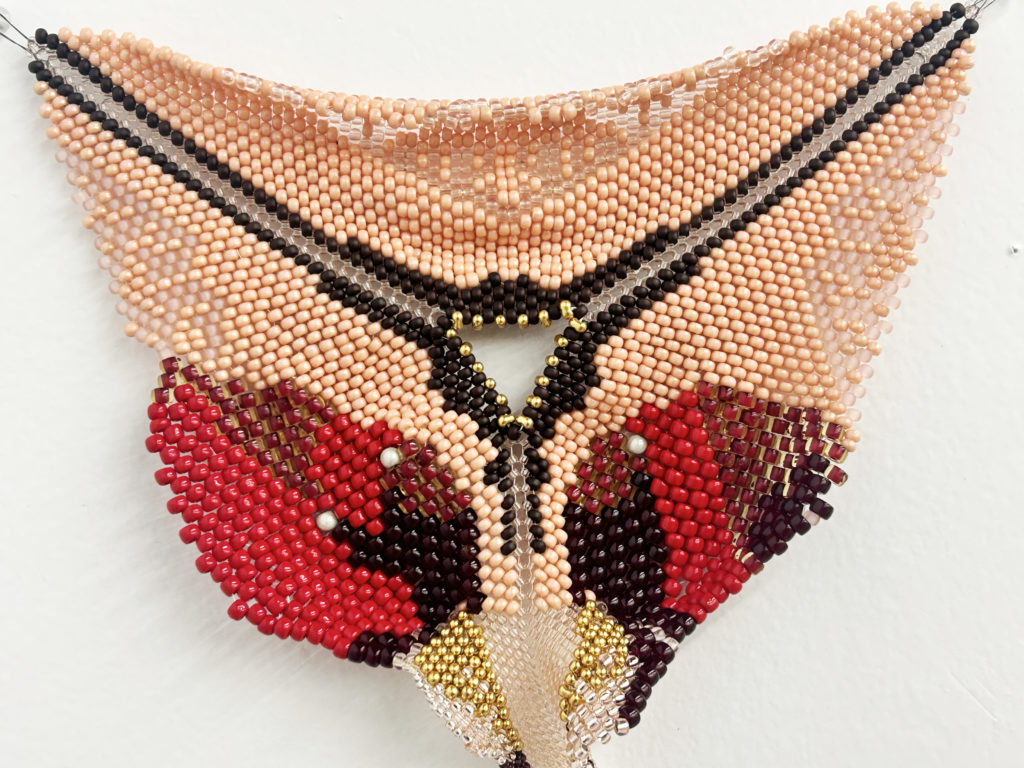WIP Artist Highlight: Elly Dec
Julie Schumacher, Artist Programs intern at TAC, got together with WIP resident Elly Dec:
Tell me about your work and your art practice. I see you've done some painting and drawing, and you make these big, beautiful sculptural beaded pieces. And I'd also love to hear how you identify those works—if you call them sculptures. But, yes, please tell me about your work.
I've always had a textile practice ever since I was really small. I learned to knit, crochet, and sew from my mother and my Polish Bobci. Bobci used to knit sweaters and hats in bulky acrylic for every one of her grandchildren each Christmas, and my mother sewed matching outfits for my brothers and me for special occasions. Photo evidence remains.
And, like for many textile people, I think making was a compulsive need. I always had to be doing something like that. Like a lot of kids, I learned to make beaded bracelets and lanyards when I was in summer camp. All of this added to a list of activities I could draw on to indulge my compulsive need to be constantly making something with my hands.
It was only when I was in grad school that I started doing bead weaving more intensely. I was living in Colorado at the time, back in the mid-1990s. I was learning some native patterns that were very fashionable back then. In the end, I realized it was a kind of appropriation, but it was also a beautiful way to enter into an exchange with more traditional and sophisticated ways of using beads. This was pre-internet, so I learned how to do peyote bead weaving from books, following patterns pretty religiously, and there wasn’t much exploration in my early practice. Eventually, I stepped away from beads and focused on knitting as a craft practice.
But then there was a juncture. Almost by accident, I began studying classical drawing and painting. I started going to the Art Students League with my youngest daughter and then to a private studio with Ken Goshen. I was developing more of an artistic sensibility about how to look at the world and how to make things. When I returned to working with the beads, I was curious to see if I could use them in a way that I had never seen before. I began using the beads in a more sculptural way, discovering patterns as I went along.
So, I began learning other traditional techniques— for example, I learned how to bezel objects. Typically, one would bezel a gem or something, but I started bezeling shells and rocks and different objects, then beading on top of that. And I was really interested in the types of forms that I was creating.
I was also really interested in the compositional aspects—how the different colors of the beads and the finishes of the beads played against each other and what all of that meant in creating these objects. The work I was making was handheld—they were like sculptures, but they were also a little bit like jewelry—they sort of had the intimacy and scale of jewelry but had a little bit more of the kind of form and compositional elements you would say were sculptural. I learned about the work of Daniel Brush, and I began to develop an aesthetic sensibility for the intimacy of the handheld piece.
But, the work was relatively small and hard to photograph effectively. I began scanning the work on a flatbed scanner, and I shared the work with a group of artists I met with weekly in a virtual Art Students League class. Our teacher, Hugo Bastidas, and the other artists responded positively to the beadwork I was doing and continued to encourage me to develop it further.
And I really felt it. You know, I definitely had an instinct that this work was something to develop further, so I started spending more and more time working on the beads, trying to discover new puzzles and solve new problems. For example, I was interested in seeing if I could get the forms bigger than the handheld sort of size pieces I was making.
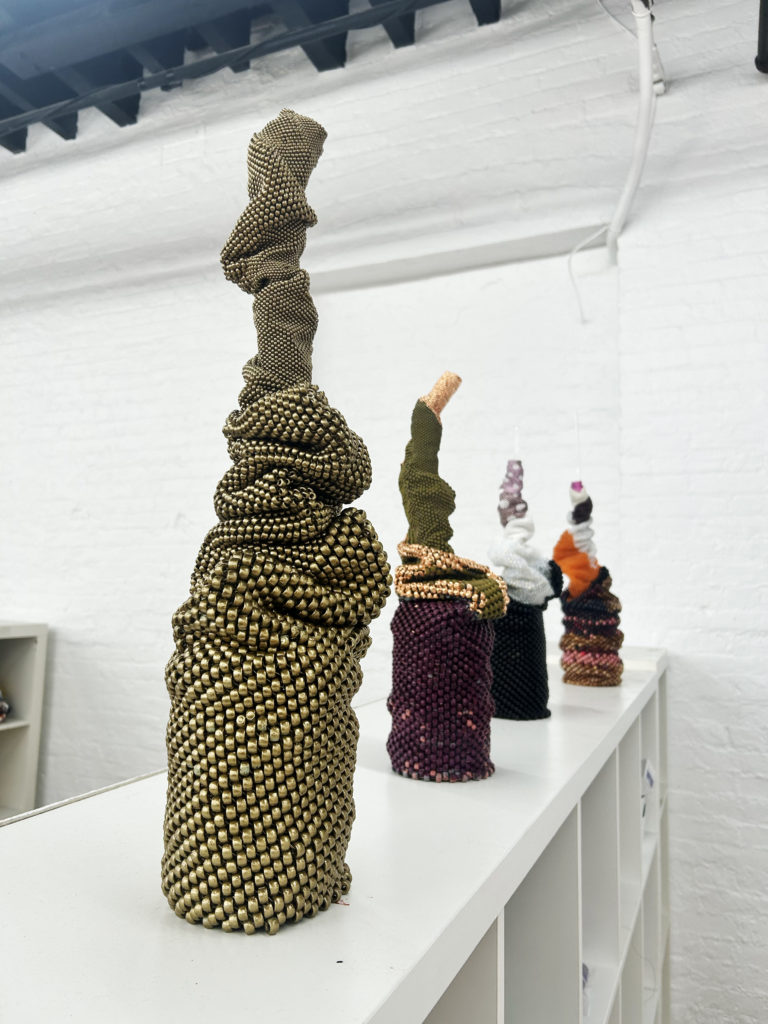
I started using larger beads and tried to simplify the format of what I was doing. I created tubes of larger beads and then gradually reduced the sizes of the beads to see how that impacted the shape of the sculptures I was making. I went on research-led side quests, learning about growth and morphology in nature. Merging this type of research with my compulsive approach to making was extremely satisfying.
I became obsessed with making these beaded tubes as sculptures. Each has a slightly different permutation as to how I moved and transitioned from larger beats to smaller ones. I place these tubes onto a form of support, and the beads find a resting posture for themselves. There's this cascade of tiny material negotiations that determine what the final result looks like when each form is sitting by itself.
These tubular sculptures are about an investigation of form and how subtle changes in the shape of cellular elements result in different forms. In the end, these sculptures all present very familiar organic feelings and shapes. I love how they respond to each other— how they enter into conversation when placed in groups and at different angles. So that's why I made that series of table sculptures.
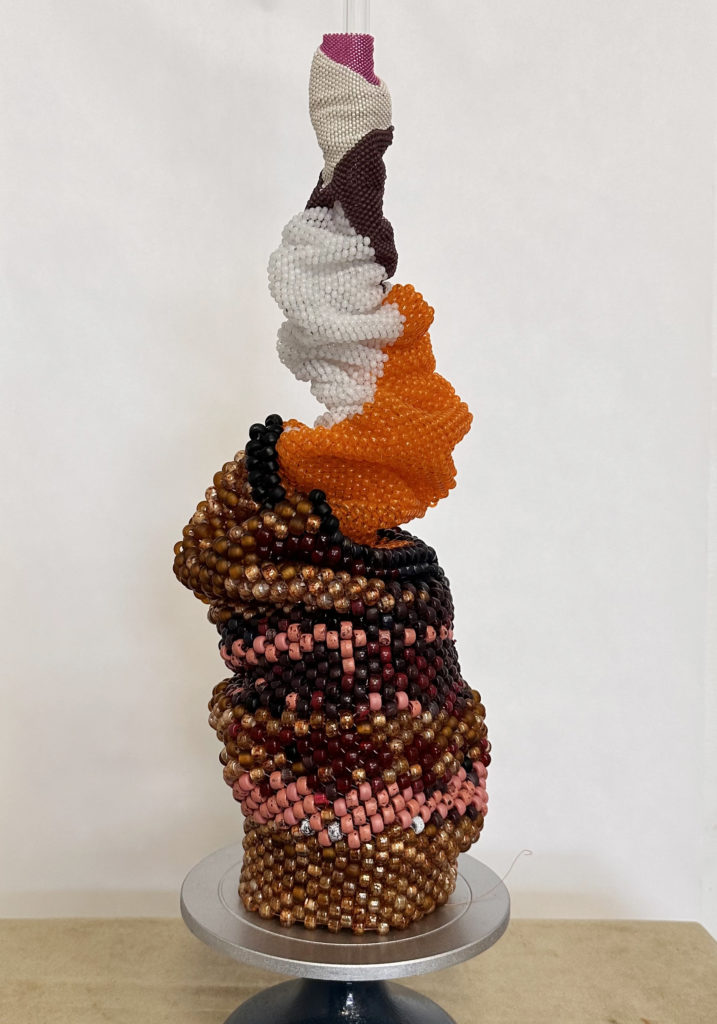
Eventually, I felt like I understood the forms very well and how the beads themselves behave—I found solutions to the questions I was trying to answer with those pieces. So then I became interested in exploring pattern. My background is in mathematics, so I'm really interested in mathematical patterns, particularly the types of patterns we call cellular automata - such as the “Game of Life” by John Conway. These are really just rules that create patterns.
Using cellular automata, each row in a matrix or grid is determined based on what the row above looks like, so you don't need a pattern at all. It's a very simple approach to pattern making—kind of like how, with stripes, you just use colors in a repeated sequence; here, the color of each bead is just a function of the color of the beads just above it.
I decided to focus on using beads as a material investigation, trying to understand these patterns viscerally rather than computationally. There's a book written by Stephen Wolfram, a physicist and mathematician, in which he classified 256 different types of cellular automata patterns. I use one of the patterns he classified called Rule 90, but in a more general sense, in logic, it's called XOR. Maybe I’m repeating this too much, but with this approach, you don't set out a design in advance—you don’t know what each row is going to look like until you actually make the work. You simply establish starting conditions and then execute the rules as if you’re on autopilot. It’s called emergence, and you can really feel it happening.
After working with XOR, I came to believe that this logic rule is a universal pattern that's been used in textile design and collective making for centuries…actually really for millennia. Looking back at ancient textiles and mosaics, you see some of these triangular patterns with little appendages on them. Whenever you see a triangular pattern with teeny little appendages, that suggests to me that they've been using this type of rule set to create a pattern on a surface.
In my work, I tend to pursue something and keep an investigation going until I feel like I've internalized the lessons the investigation can give me. Like with the tubes, my slumpy tubes, I finally internalized the lessons. I made maybe 15 of those guys, and then I was like, Okay, I understand it. I have enough. And now there are enough of them that I can play with them and position them in interesting ways. So it is with XOR, this basic rule, that I am using for pattern-making. And I'm not bored of it yet. There is more to discover. This is an ongoing investigation.
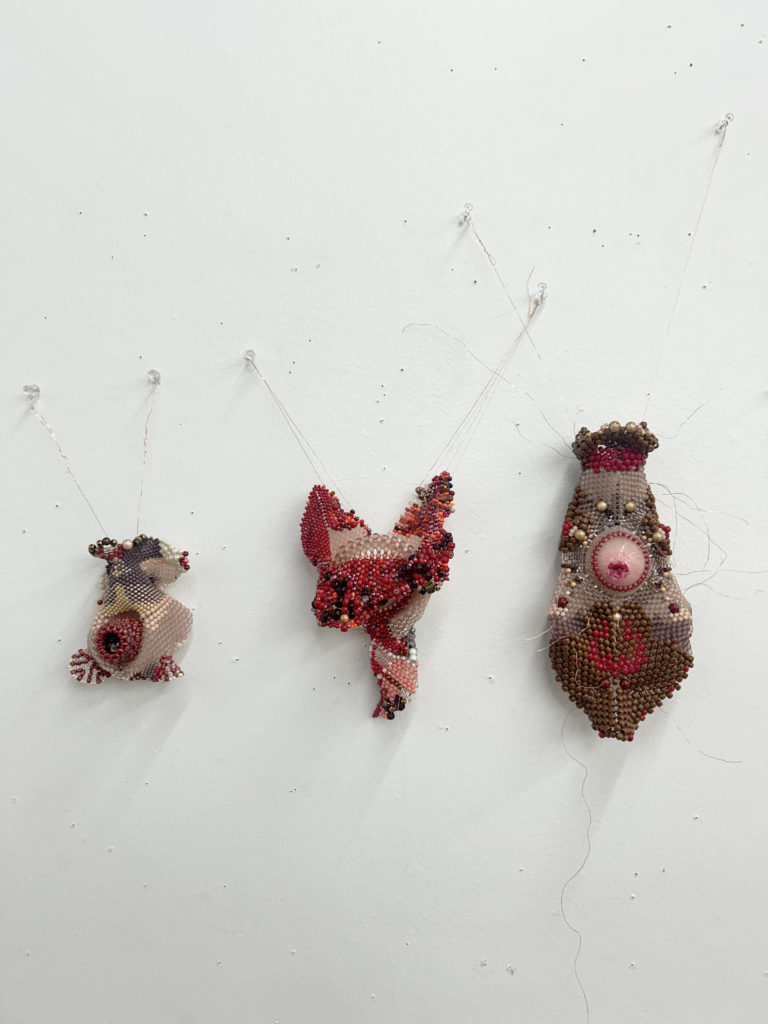
Do you ever have a sketch or a maquette of the form before you start? Or do you start with just the problem or rule in mind and a color palette and are surprised by the final result?
You know, I’m not so interested in making something if I know exactly what it will look like. So, I see this work as a series of material investigations, but sometimes, I have to push things further if it's boring or repetitive. I find that if I push the work further than I think I'm interested in—if I get it past a certain point—there's always something there.
And it's the same with rule-based patterns—At this point, I broadly know what they're going to look like. But often, a small mistake or glitch in one row leads to a very different expression of the pattern further down the line, and that is exciting to me. The way the colors wind up combining, I never know in advance what kind of color interactions I'll have—that's interesting to see over time as the piece gets larger.
When you're doing your investigations, do you have any grander kind of mathematical problem you're trying to resolve? Or, similar to your painting and classical drawing, is the work an artistic and formal exploration of mathematics, pattern, and form?
When it comes to the mathematics that I'm thinking about when I'm making these patterned wall hangings, I realized that this rule is probably used in a lot of collective making. This is not just in spaces where humans are making things; other creatures might be using this type of rule in collective-making efforts, like termites or mycelium or other forms of life that exhibit building behaviors. And these rules, especially the one that I'm using, XOR, no matter what your starting conditions are, you'll always get something that seems vaguely symmetric. You always get something that wants to converge to a symmetric and stable system. I discovered that symmetry is more than a compositional or engineering strategy. It is actually an emergent property of the computational rules of nature. It really makes me wonder if these rules can help us understand growth and collective forces in non-human domains.
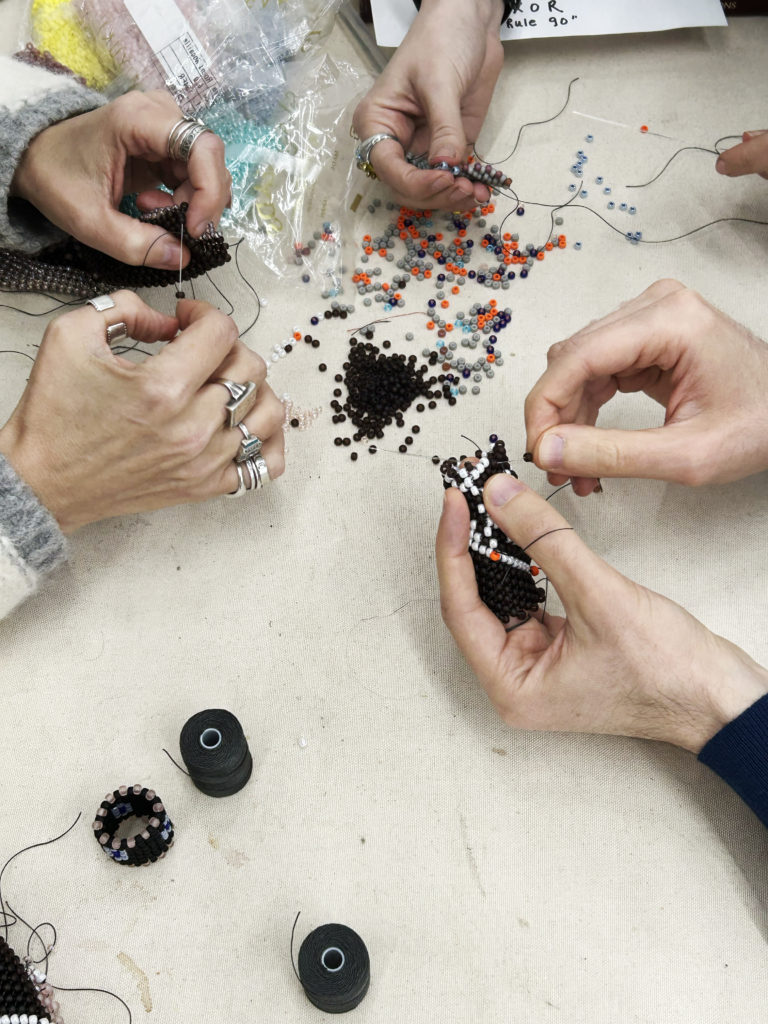
The other thing that I'm really interested in is how these patterns are like a kind of cryptography. If I were to take away the starting conditions and only give a bit of the picture toward the end, it would be very difficult to guess the starting conditions. You can't work backward. It's easy to propagate the rules forward, but it's almost impossible to propagate them backward. That suggests there are a lot of applications in cryptography or in authentication that could benefit from these types of approaches, and it's a very easy way to create patterns that you can use to ensure authenticity.
There's a Discord community that talks about Stephen Wolfram's work, and they're mostly scientists: mathematicians, computer scientists, and physicists. But I post some of my work there, and I think the community is interested in seeing it. They're having very deep conversations about patterns—not because of my work, of course, but because it's nice to connect my artwork with researchers who are exploring the nature of computation in totally different ways. And they’ve shared code with me, so I can generate patterns online. So, these are the types of mathematical applications that I'm thinking about in my practice.
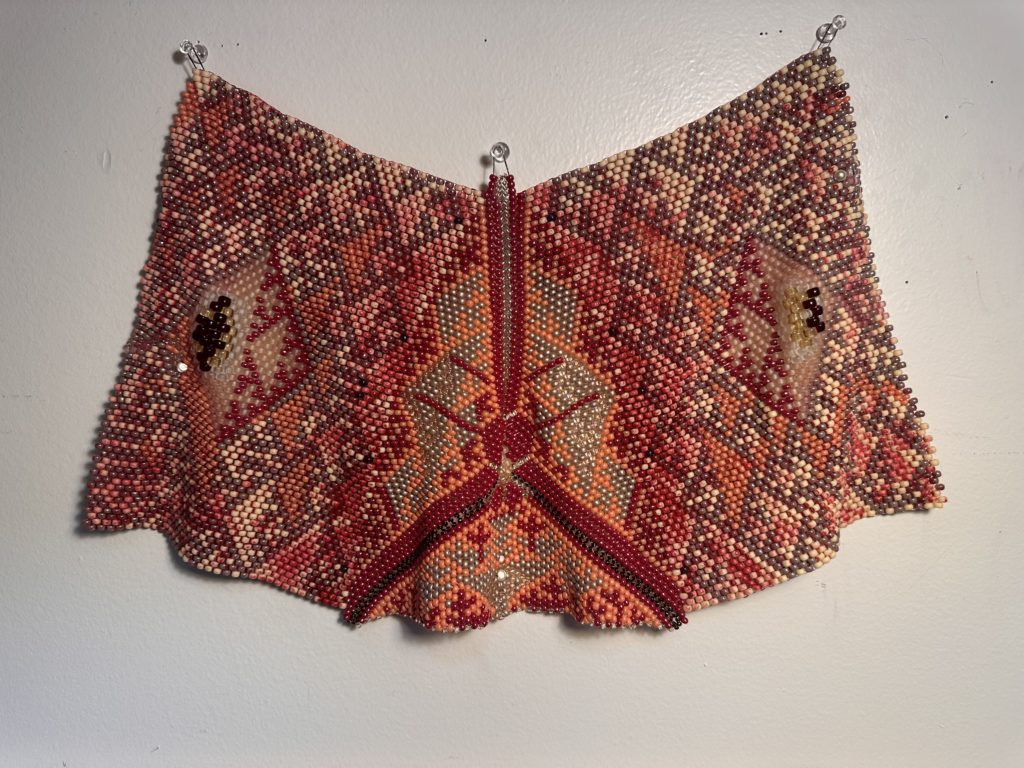
So fascinating. And what are you excited to explore next?
Before starting my WIP residency, I was starting to scale up these wall hangings. I'm interested in finding ways to be more strategic about design—using colors more intentionally and not playing mind games with myself about colors, but instead starting with a real design in mind and trying to achieve larger works—potentially combining other materials. I have started painting on the beads and using dyes and inks, and this is definitely a path for further exploration.
The tactile aspects of my work have always been very important to me, and I really want to make work that is accessible to people who are blind or visually impaired…so this is another conversation I want to develop further.
At the Textile Arts Center, I took the opportunity to hang some of my earlier handheld pieces in my studio space, and I now look at them with new eyes. Conversations with the other artists here and with visitors have led me to consider returning to bezeling and to the more visceral and intimate themes of my earlier work. I am so thankful for this opportunity, which has helped me and my practice in very deep and important ways, and for the beautiful community of artists I have met here.
